9 SaaS Marketing Strategies (And How To Choose The Right Ones)
Last updated: August 25th, 2025
Most B2B SaaS marketers construct a marketing strategy by selecting a handful of channels based on two factors:
- The teams’ personal experience and expertise in a particular marketing channel
- The marketing channels competitors are using
However, a marketing strategy is fundamentally a method to attract ideal prospects and convert them into customers.
Therefore, an effective marketing strategy is built around how the prospect experiences the buyer journey.
The marketing channels incorporated into the strategy are simply the touchpoints a prospect organically uses to research, evaluate, and select a solution.
In this post, we’ll discuss the most popular marketing channels (as that’s often the main topic of conversation when discussing a marketing strategy).
However, unlike most marketing strategy content, which simply provides best practice advice for executing each channel, we’ll answer the two most important questions:
- When is the right time to invest in this channel?
- If you’re already investing in the channel, what are the common mistakes that most SaaS companies make, resulting in average performance?
At the end of this post, we’ll also discuss how we create a SaaS marketing foundation and build a flywheel that makes each channel progressively more effective.
The 9 Most Important SaaS Marketing Channels
Here are the nine most important SaaS marketing channels that we frequently execute for clients.
1. SEO
Should SaaS companies invest in SEO in 2025?
We frequently receive this question from SaaS companies, and given the rise of LLMs and the fact that Google’s AI overviews are reducing website traffic, it’s certainly a valid concern.
First, LLMs like ChatGPT are indeed capturing a significant percentage of traffic, but Google still holds a substantially larger market share than any other LLM.
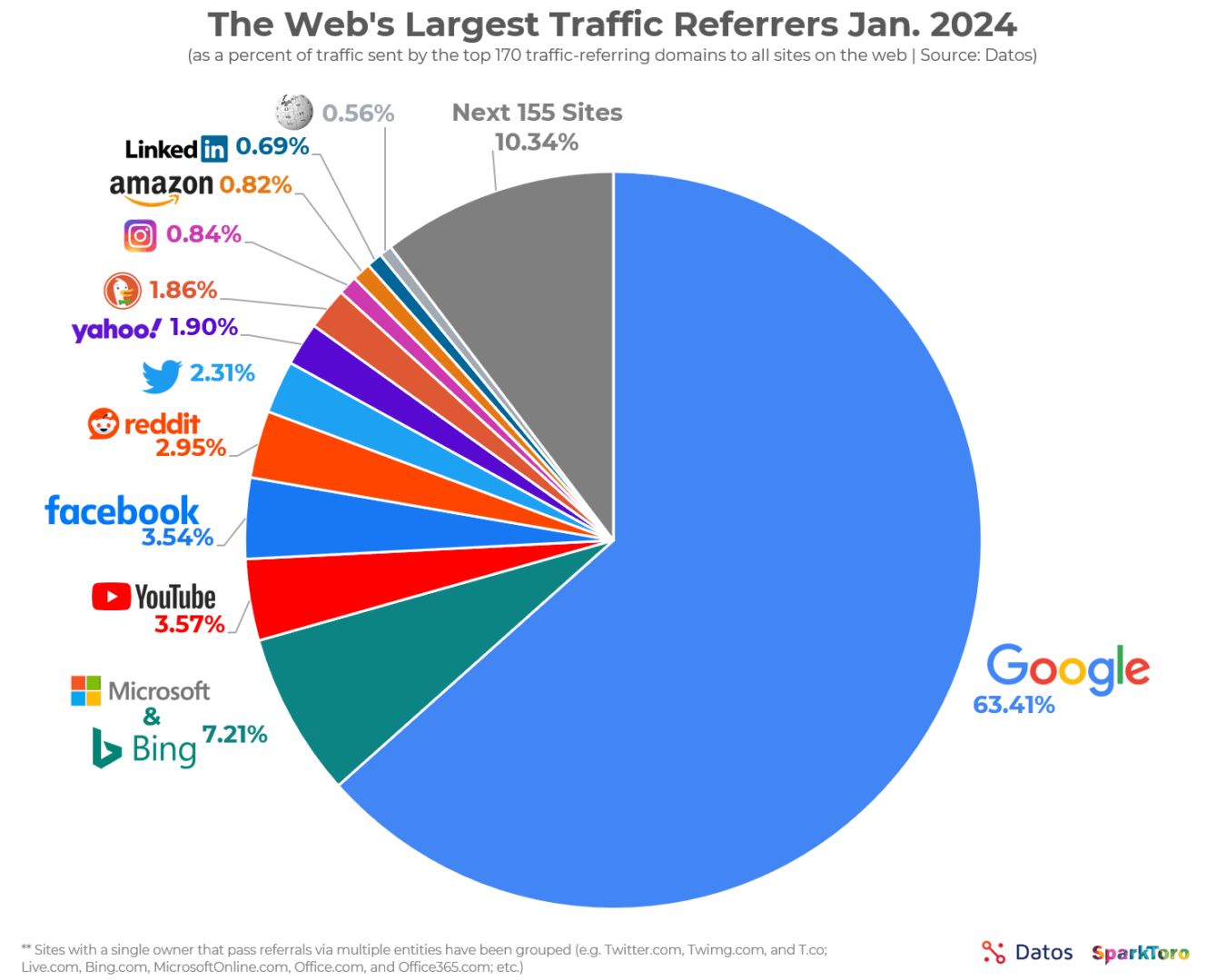
Additionally, while Google’s AI overviews are significantly reducing website clicks, Google search still drives plenty of qualified leads for our clients.
Yes, top of funnel traffic is decreasing, but conversions remain strong.
The key is to shift your thinking from optimizing for traffic (which we’ve always believed is a flawed metric given that it doesn’t always correlate with conversions) and instead:
- Use conversions and leads as the core KPI to measure content success.
- Shift leading indicators from generic traffic to rankings for high purchase intent keywords.
We have a more detailed guide discussing our SaaS SEO playbook, but our core philosophy on SEO is to shift the focus from volume to impact.
From a tactical perspective, here’s how we shift focus from chasing traffic to maximizing conversions:
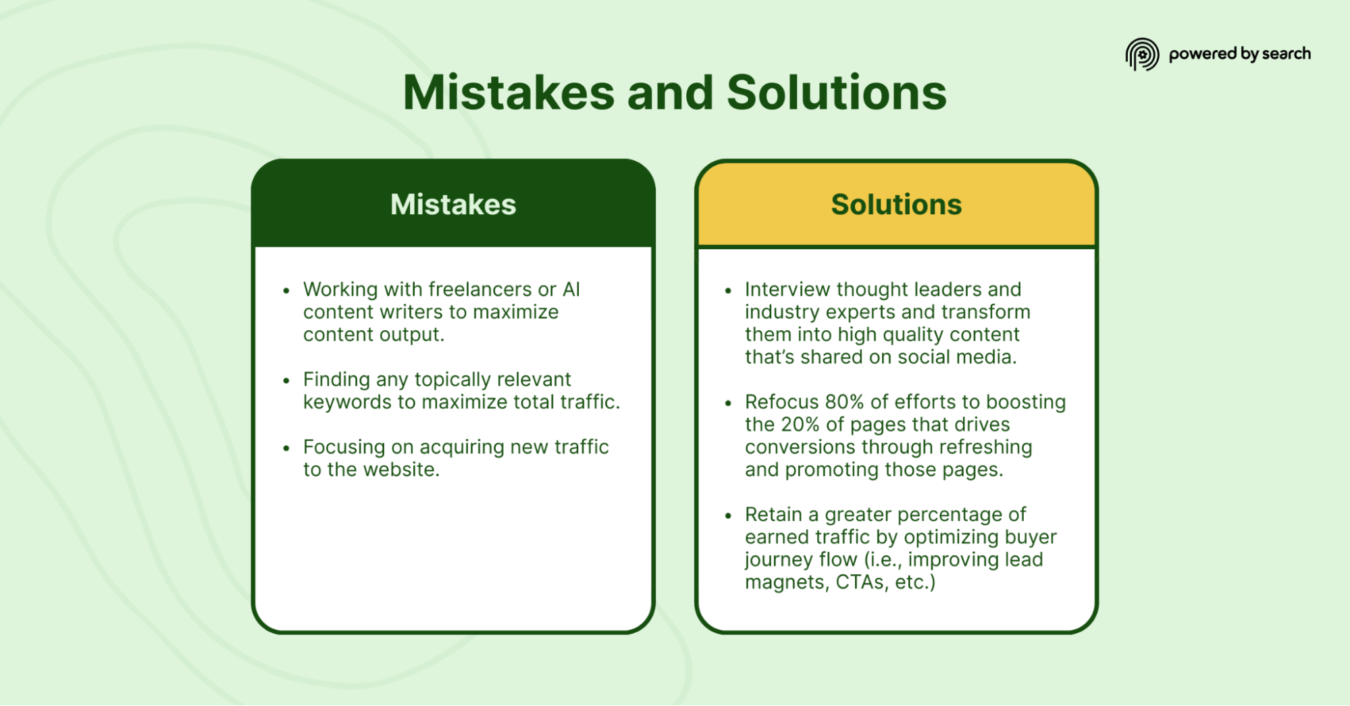
If you want to learn more about how we tactically implement our SaaS SEO playbook, here’s a brief overview:
- Create: Prioritize high-intent, conversion-ready keywords. Refresh existing content rather than always writing new content.
- Structure: Align site architecture, content, and CTAs to seamlessly connect each stage of the buyer journey.
- Promote: Earn high-quality, contextual links to pages that drive conversions by building relationships with relevant industry leaders.
- Integrate: Break down silos between content, SEO, and link-building teams. Focus all efforts on boosting pages that contribute to demos and revenue.
2. Content Marketing
You can have the best technical SEO in the world, but it won’t drive any traffic if you don’t have information addressing a prospect’s search questions.
Therefore, content marketing is essential for every SaaS company.
A better question is:
How much should we be investing in content marketing, especially if our current strategy isn’t yielding results?
The answer to this question depends on two variables:
- If you have content targeting all of your highest converting (BOFU) keywords
- The quality and rankings of the content targeting those keywords.
For reference, the highest converting (BOFU) keywords we’re looking for follow these four frameworks:
- Comparison pages (e.g., “Your SaaS vs Competitor”)
- “Alternative to” pages
- “best” (industry/persona) software
- Pain points your most popular features solve
After identifying the keywords that fit those frameworks, we prioritize updating content that’s already within striking distance (e.g., positions 4-15 for the main keyword).
Why start with content within striking distance?
CTRs increase significantly as you move up even just a few spots on the first page, so targeting this low hanging fruit will give you the biggest immediate lift:
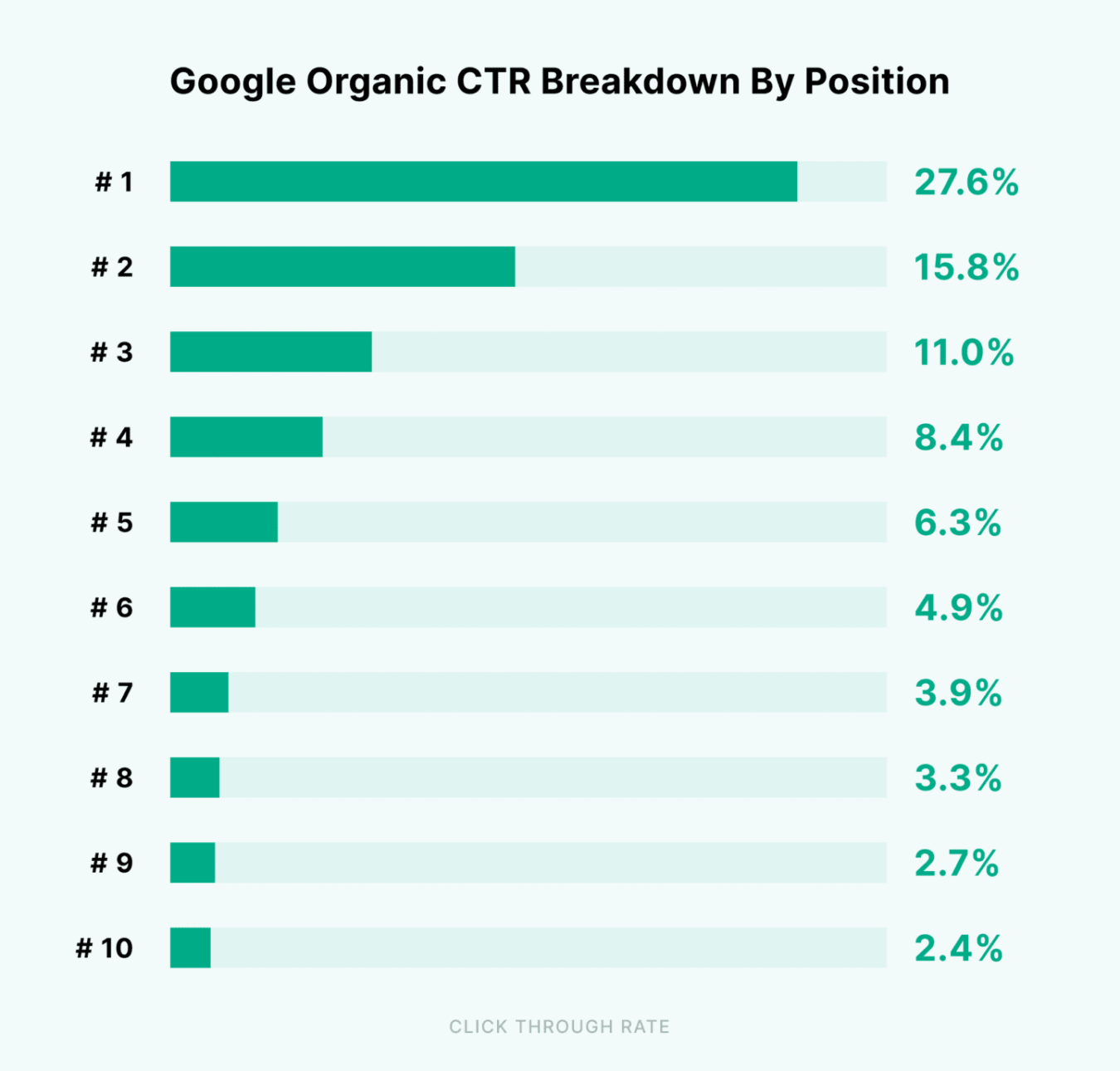
Once we’ve updated all those keywords, we’ll move down the list and refresh content that targets high-intent keywords but ranks below position 15 for the target keyword.
Finally, we’ll move on to creating new content for the remaining high-intent keywords on the list.
To refresh the content, we interview thought leaders to craft unique insights that allow it to stand out from generic and AI content. (We’ll also build links to these pages, but more on that later.)
Additionally, we optimize the blog design to capture and retain a greater percentage of traffic.
Specifically, most visitors aren’t ready to sign up for a demo the first time they land on your website. Therefore, instead of leaving just a generic CTA to book a demo, we create offers relevant to each stage of the buyer journey to retain maximum traffic.
3. Digital PR and Link Building
Your content marketing efforts won’t move the needle if nobody sees your content. Even if you refresh existing content, you might not have enough page authority to outrank your competitors.
Digital PR and link building can solve this problem.
That said, if you’ve ever tried running a link building campaign, you know that most campaigns have very low response rates and don’t meaningfully move the needle.
The problem is that most of these link building campaigns lack targeted goals. They’re building links to the generic homepage from any website with a high domain authority.
Instead, here are a few principles that make our digital PR and link building effective:
- Build links to high converting pages in “striking distance” rather than the homepage
- Select link partners based on page authority, traffic, and other metrics rather than generic domain authority.
- Reach out to the right person with an offer that makes their life easier rather than a generic request.
Here’s a full overview of our methodical approach to link building and digital PR:
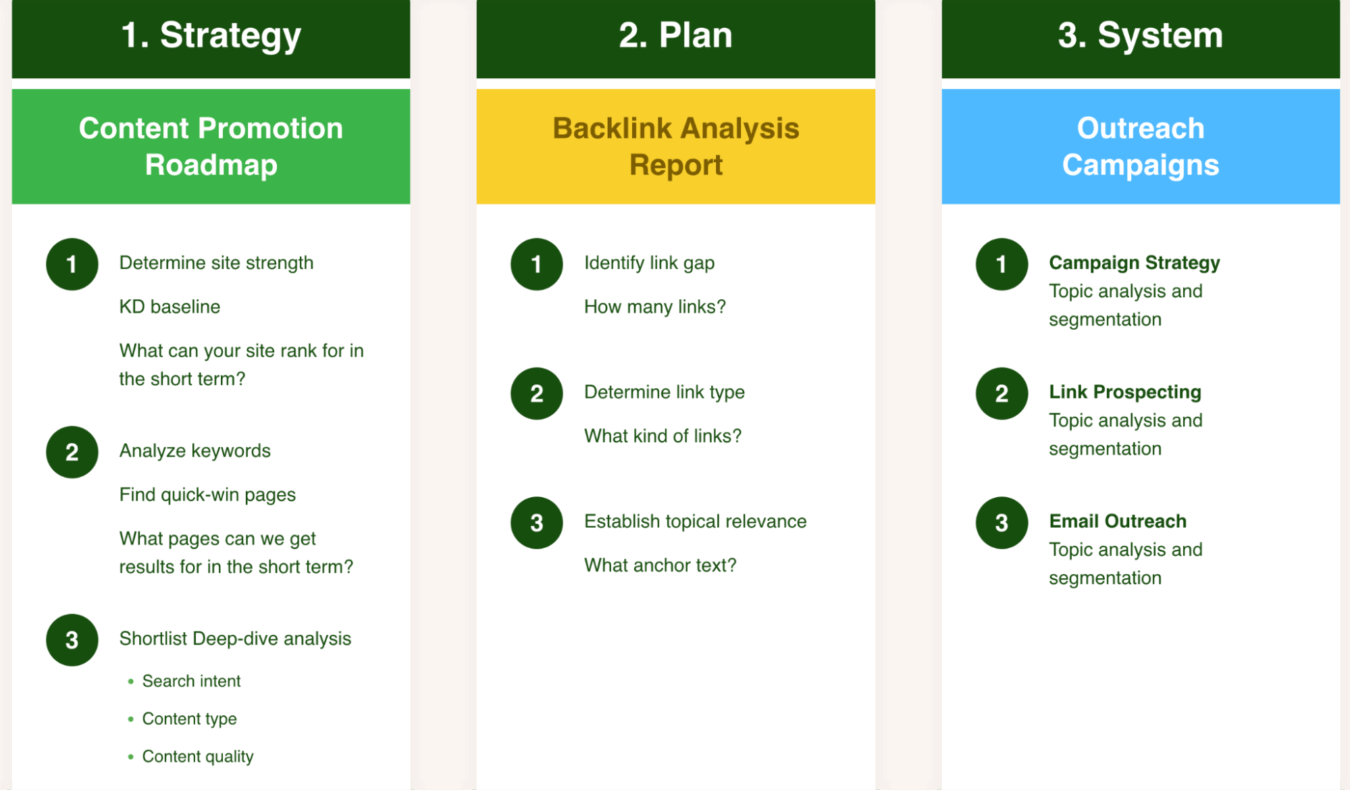
4. AEO
“How do we show up in ChatGPT?”
The answer to this question is AEO – Answer Engine Optimization.
AEO is a strategy to rank higher in modern AI search tools, such as ChatGPT, Perplexity, Claude, Gemini, and dozens of niche AI agents.
First, having a strong SEO foundation (and a strong brand) certainly helps. However, there are important nuances that make AEO unique.
So, in addition to executing SEO, we also implement the RAISE framework. We outline this framework in more detail in our guide to ranking in LLMs.
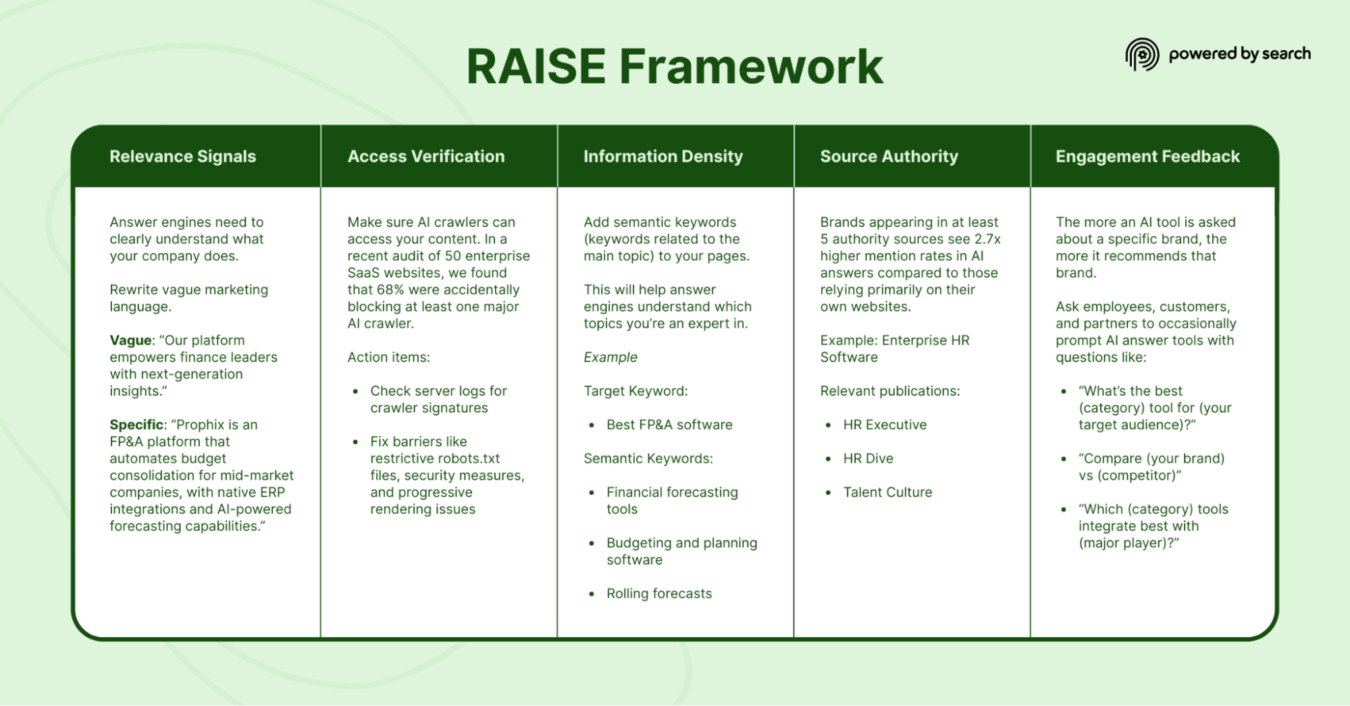
5. Facebook Ads
While it may not be the first platform that comes to mind for B2B SaaS, Facebook Ads can be a powerful platform if your audience is active on the platform and matches one of its specific target audiences.
For example, we worked with a B2B SaaS whose target audience was restaurant owners. While only some of these restaurant owners are active on LinkedIn, many of them have Facebook profiles. And, Facebook allowed us to target restaurant owners directly.
This ultra specific targeting made Facebook a highly effective channel for not only generating brand awareness, but also generating qualified leads.
Even if your audience is primarily on LinkedIn, Facebook is excellent for retargeting and general brand awareness campaigns.
If you’ve tried Facebook ads before and it hasn’t worked, it’s usually due to one of these three issues:
- Imprecise targeting
- Insufficient creative testing
- Neglecting on platform lead generation
Beyond simply executing best practices for Facebook ads, here’s the 80/20 of successful Facebook advertising:
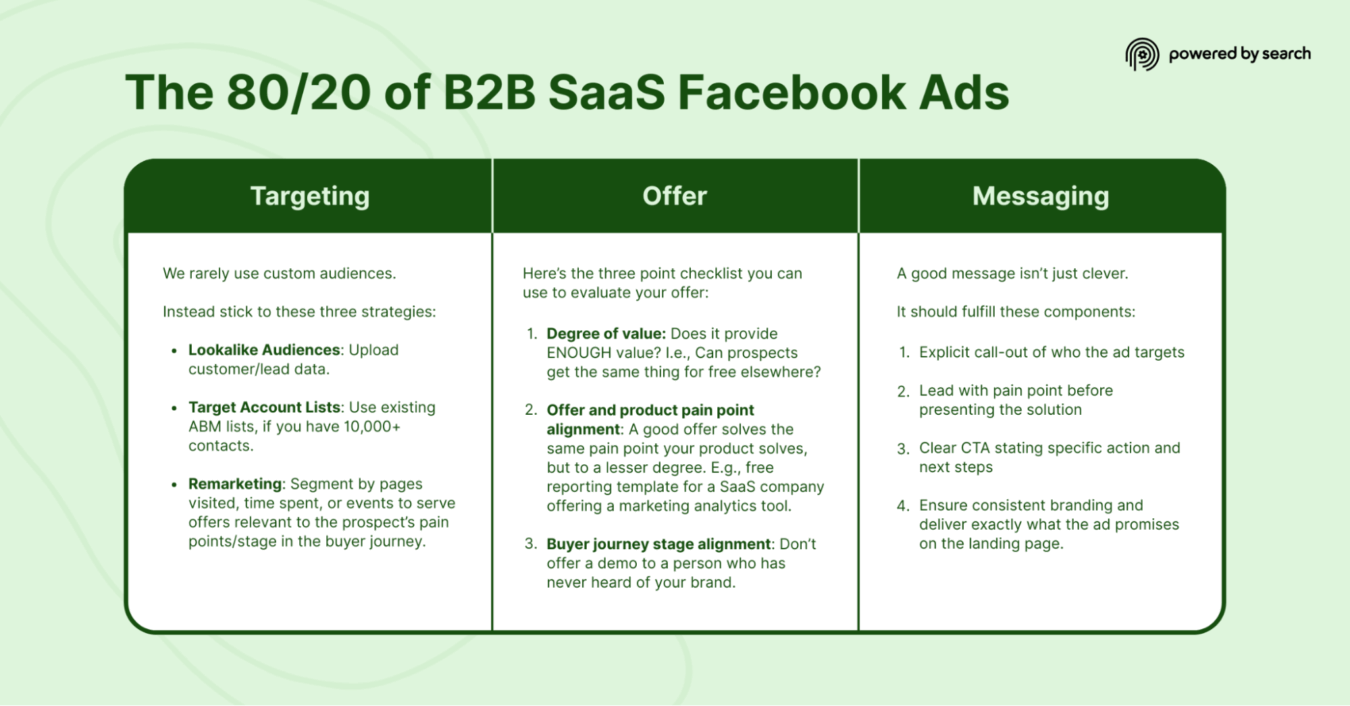
For more detailed information, we have a dedicated resource outlining our approach to running Facebook ads for B2B SaaS, and explain each step in more detail.
6. ABM
ABM (account based marketing) is ideal for B2B SaaS companies that sell to enterprise or mid-market buyers with long sales cycles, as it allows you to target specific people within a target company.
While ABM is a powerful tool, many prospects tell us that it’s too expensive and doesn’t convert well enough.
In these cases, we typically find that the company is making one of the following three mistakes.
- Exclusively using firmographic data for targeting: Just because a company fits your ICP doesn’t mean they’re actively looking for a solution. Only target in-market accounts that show real purchase intent. You can use intent platforms like 6sense, Bombora, or Demandbase to identify in-market prospects.
- Running ABM like a generic demand gen campaign: A key reason ABM ads can deliver outstanding results is that you know exactly who you’re targeting and can therefore deliver a hyper-personalized message that speaks to their specific pain points.
- Ignoring the prospect’s stage in the buyer journey: If your buyer journey lasts six, twelve, or eighteen months, a message that resonated in month one likely won’t resonate at month 12. Calibrate your messaging to match the prospect’s stage in the buyer journey.
ABM campaigns are more complex to set up, so here’s our five-step ABM process. However, once you have them set up and follow the blueprint, ABM is very powerful for B2B SaaS companies selling to enterprises.
7. LinkedIn
LinkedIn ads are a staple for many B2B SaaS companies because they allow you to target key decision makers by job title, industry, company size, and other filters that aren’t available on Google or Facebook.
Therefore, we typically use LinkedIn ads if:
- You sell to enterprise or mid-market companies.
- Your buying committee includes multiple decision-makers.
- Your sales cycle is long and complex.
- You already have strong positioning and messaging dialed in.
If you’ve tried LinkedIn and it hasn’t yielded a great ROI, it might be due to one of these three common mistakes:
- Exclusively targeting bottom of funnel prospects: Most enterprise buying cycles last about 12 or more months. If a prospect learns about your product after they’ve already talked to several other brands, it’s unlikely they’ll consider your product.
- Inaccurate targeting: SaaS companies often misuse the “AND” and “OR” functionality in LinkedIn targeting. Similarly, only targeting one person involved in the buying committee won’t get you the buy-in you need to close a deal.
- Using the wrong content at the wrong time: Someone at the top of the funnel might not be interested in a case study whereas someone at the bottom of the funnel is probably too advanced for a basic checklist.
We have a detailed LinkedIn ads playbook for B2B SaaS, but here’s a brief synopsis of our approach:
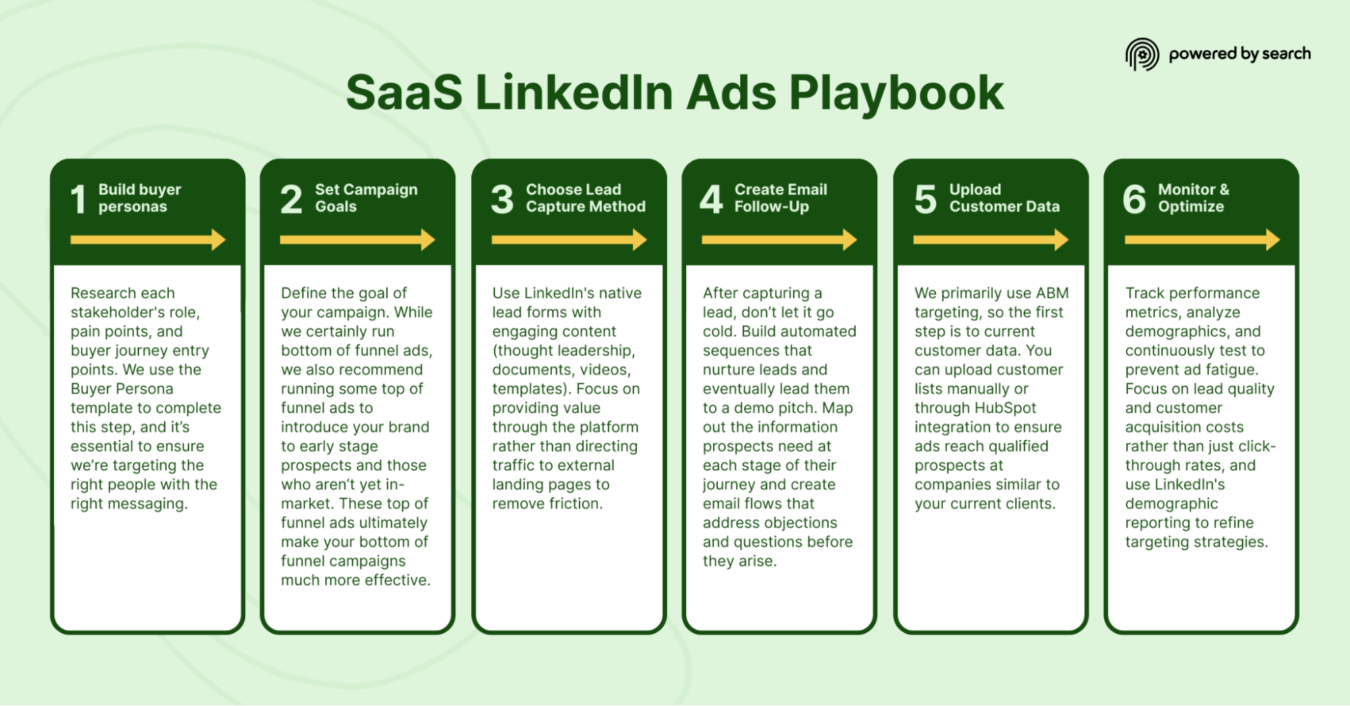
8. Google Ads
Google Ads are another staple of B2B SaaS marketing, and they’re unique from paid social channels because you’re bidding on keywords, not an individual’s title, company, or characteristics.
By bidding on keywords, you can pinpoint people who are in-market by reverse engineering the intent behind a specific keyword.
To help you identify the right keywords and allocate budget appropriately, here are the keyword frameworks we recommend for B2B SaaS companies:
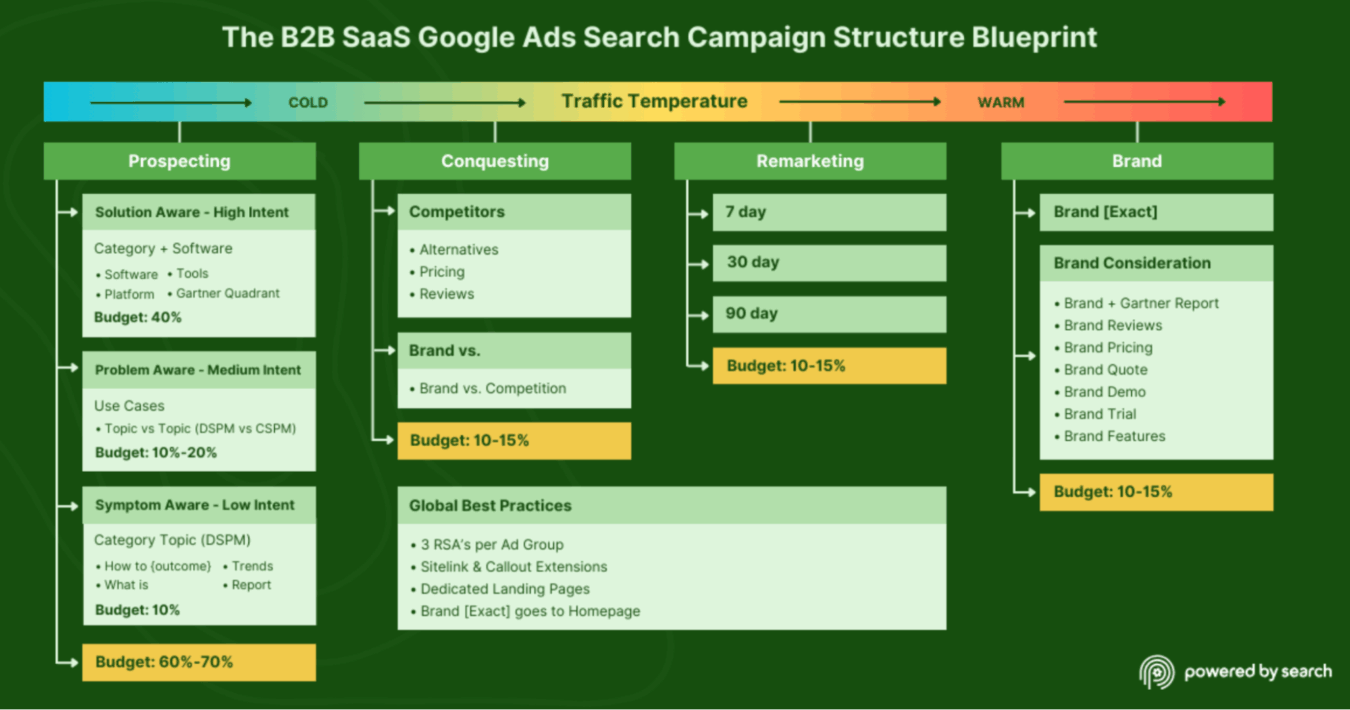
To further improve the performance of your Google ads, here are some additional best practices we recommend in our SaaS Google Ads playbook:
- Use Three RSAs Per Ad Group: If you’re only rotating one or two ads per ad group, you simply don’t give the platform sufficient opportunities to improve conversion rates.
- Sitelink and Callout Extensions: These give you more real estate in the search result and encourage prospects to take action while also reducing the visibility of your competitors.
- Dedicated Landing Pages: We often see SaaS companies drive prospects to a generic homepage. Instead, send them to a dedicated landing page that matches their stage in the buyer journey and offers a calibrated call to action.
- Exclude Existing Customers: Create a list of existing customers and exclude these people from brand query campaigns. In most cases, it makes more sense to upsell existing customers through email and other cheaper methods.
9. Email Marketing
When used appropriately, email marketing can be a highly effective strategy to nurture prospects and increase the LTV of existing customers.
However, simply sending emails doesn’t mean your email marketing is effective.
Most companies are making one of the following mistakes:
- Sending one off emails instead of sequences.
- Emailing generic lists rather than segmenting the audience.
- Copywriting that doesn’t speak to the customer’s pain points
To solve for these problems, we have a handful of specific email nurture sequences that we implement for three of our B2B SaaS clients:
- Nurture campaigns: The goal of these campaigns is to convert prospects into MQLs. Specifically, we have templates for lead to MQL sequences, trial welcome sequences, and pre-demo/pre-webinar welcome sequences.
- Activate: These campaigns are sent to current customers and are designed to either upsell them or educate them on how to use your product more effectively.
- Revive: Not all churned customers are a poor fit for your brand. Depending on the reason a customer churned, you can send them a revival email to win back their business.
We have a more detailed guide outlining our full SaaS email marketing strategy, along with execution tips.
Why a Collection of Marketing Channels Is NOT A SaaS Marketing Strategy
Many of the underperforming SaaS marketing strategies we audit have great tactical execution.
The root of the problem often lies in the team’s fundamental approach to building a marketing strategy.
Specifically, they’ll analyze the marketing channels their competitors are using and then execute similar campaigns.
The problem with this approach is twofold:
- Pain point misalignment
- Disconnected user experience
Pain Point Misalignment
You probably know the basic problems your customers face. If you’re a cybersecurity software provider, security is the obvious pain point.
Yet there are three specific nuances to pain point alignment:
- Committee member: An end user often cares about making their job easier, whereas a check signer cares about ROI and organizational impact. You must know which member of the buying committee you’re addressing.
- Timing: At the beginning of the buyer journey, the pain point is more general – identifying a secure solution. At the end of the buyer journey, the pain point is more specific – how is Cybersecurity A better than Cybersecurity B? Does it offer Feature XYZ to prevent a specific type of attack?
- Accuracy: You might think people are buying your cybersecurity solution for a specific feature, yet they might actually choose you because your customer support is superior. However, if you don’t use qualitative and quantitative data to identify these reasons, you’ll never know. As a result, messaging around your special feature won’t convert.
Disconnected user experience
Prospects don’t conform to the buyer journey you lay out. To effectively attract, convince, and convert prospects, you must construct a marketing channel that aligns with how they experience the journey.
Specifically, this means:
- Your CTA must be calibrated to their stage of the buyer journey: We often see SaaS companies offer a CTA to schedule a demo, yet if the prospect is in the problem awareness stage, they aren’t ready for a demo. The CTA instead needs to offer a smaller ask, like a free calculator or template.
- The messaging on the next channel must be congruent with the previous channel: We often see SaaS companies have messaging targeting a slightly different pain point from one touchpoint to the next. It may be very slight – as simple as incorrect timing of a correct pain point. However, even a slight disconnection in messaging can cause a prospect to exit the buyer journey.
In short, a collection of tactically flawless marketing campaigns is not an effective marketing strategy.
The solution to building a profitable marketing strategy is taking a data-driven, holistic approach that meets prospects where they’re at and provides the knowledge they need to overcome objections and convert.
This is the fundamental principle behind our Predictable Growth Methodology, which is the cornerstone of our marketing philosophy here at Powered by Search.
How To Build a Sustainable SaaS Marketing Strategy
The Predictable Growth Methodology is a systematic approach that creates a flywheel where each marketing initiative builds on the previous efforts, making the overall strategy progressively more efficient.
Here’s how it works.
Step 1: Evaluate Your MRR Accelerators
Identify the seven types of “fit” beyond product-market fit that impact monthly recurring revenue growth. For example, Message-Market Fit, Customer-Channel Fit, and Customer-Content Fit are all “fits” that impact the efficacy of your marketing, and therefore, your revenue.
Audit your marketing strategy by combing through each of these “fits” and uncover the weakest points.
Note: As you’re auditing your marketing strategy, use real data – not assumptions.
You can also understand why website visitors aren’t converting by analyzing data from your customers’ perspective, rather than relying on internal assumptions.
Step 2: Understand Customer Intent and Pain Points
Assuming you know who your best customers are and their pain points is dangerous.
Yes, you probably generally know who is buying your product, but do you know:
- Every title involved in the buyer journey (Who brought it up first in the company? It isn’t just the check signer)
- Which channel did they find you through? (You might see leads from LinkedIn ads, but it was actually a blog post the saw earlier that first made them interested in your company.)
- Why they chose your product over the competition? (You might think it’s feature-related, but they might say it’s because your customer service is better.)
Answer these questions with data.
Specifically, we gather qualitative data from product, engineering, customer success, and analytics teams.
We also gather data from the CRM and sales calls to better understand pain points and how they phrase them (this will impact your messaging).
Step 3: Pinpoint Visitor Conversion Issues
Analyze why current website visitors aren’t converting into demos and trials. Look in your CRM to see which lead magnets perform the best and which ones have not been successful.
Look at Google Analytics to identify where users leave your website. These insights are essential for tying together the customer journey.
Step 4: Educate and Motivate Ideal Prospects
Publish content and messaging that addresses your prospects’ specific needs and pain points, and guides them towards a demo or trial.
If you’re only targeting bottom of the funnel visitors, you’ll see low conversion rates. Remember that enterprise purchases are considered purchases and don’t happen overnight. Therefore, you can’t expect to show up in a prospect’s feed at the last minute and win their business.
Step 5: Drive Right-Fit Traffic
Implement both paid and organic marketing campaigns to attract visitors who are most likely to convert into qualified prospects and eventually paying customers.
For this stage, you can use a tool like SparkToro to identify the channels your best customers use to research problems and discover solutions. Then, run campaigns on those channels.
Step 6: Creating a Proof of Concept Pilot Project
Instead of questioning whether your strategy will scale, focus on proving that you can turn a click into a customer through a repeatable process.
The Pilot Project is a simplified version of your demand generation program targeting your highest-value audience.
It tests three critical fits:
- Customer-Channel Fit (testing paid channels like Google Ads, Facebook/Instagram, and optionally LinkedIn for high-LTV products)
- Customer-Content Fit (converting visitors to leads through valuable content like guides or calculators with minimal form fields)
- Journey-Offer Fit (using thank-you pages and follow-up campaigns to convert leads into demos/trials).
This approach generates quick wins and momentum while establishing benchmark metrics and reducing the cost per acquisition over time.
Step 7: Measure and Generate Insights
Many marketers use vanity metrics to measure the efficacy of their marketing campaigns. We tie actions to ROI.
Specifically, look at:
- MRR Velocity
- CAC Reduction
- LTV Growth
Step 8: Create Your MRR Acceleration Roadmap
After you’ve had time to gather some data, prioritize initiatives using three criteria:
- Highest impact adjustments in the shortest timeframe,
- Simplest to deploy changes with minimal dependencies
- Most proven ideas based on historical success.
Once you’ve prioritized initiatives, assign them to relevant teams with detailed briefs explaining best and worst-case outcomes.
Here’s exactly how we approach project management to ensure these initiatives are executed:
- Assign each initiative to a Directly Responsible Individual.
- Break down initiatives into actionable tasks that take less than a week to complete.
- Ensure initiatives have a small project team (3-5 people) and everyone knows who does what and by when.
This process ensures that these “important, but not urgent” tasks are completed.
Level Up Your B2B SaaS Marketing Strategy
This is an overview of how we approach SaaS marketing, but if you want more tactical information, you can read our playbooks (linked in each of the paragraphs above) on each marketing channel.
However, as we discussed, building an effective SaaS marketing strategy isn’t just about executing hacks and tactics to make a channel perform better.
It’s really about creating a solid foundation and then building a flywheel where each marketing initiative becomes progressively more efficient.
Of course, uncovering these opportunities and fixing them is the hard part. If you need help, reach out to our team today. We can help you find key opportunities to improve your strategy and support you in the execution process. Claim your Free Marketing Assessment today to improve the efficacy of your SaaS marketing strategy.
What you should do now
Whenever you’re ready…here are 4 ways we can help you grow your B2B software or technology business:
- Claim your Free Marketing Plan. If you’d like to work with us to turn your website into your best demo and trial acquisition platform, claim your FREE Marketing Plan. One of our growth experts will understand your current demand generation situation, and then suggest practical digital marketing strategies to hit your pipeline targets with certainty and predictability.
- If you’d like to learn the exact demand strategies we use for free, go to our blog or visit our resources section, where you can download guides, calculators, and templates we use for our most successful clients.
- If you’d like to work with other experts on our team or learn why we have off the charts team member satisfaction score, then see our Careers page.
- If you know another marketer who’d enjoy reading this page, share it with them via email, Linkedin, Twitter, or Facebook.